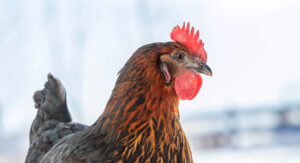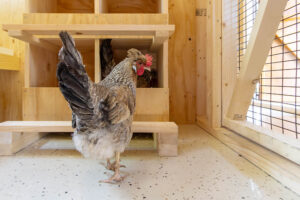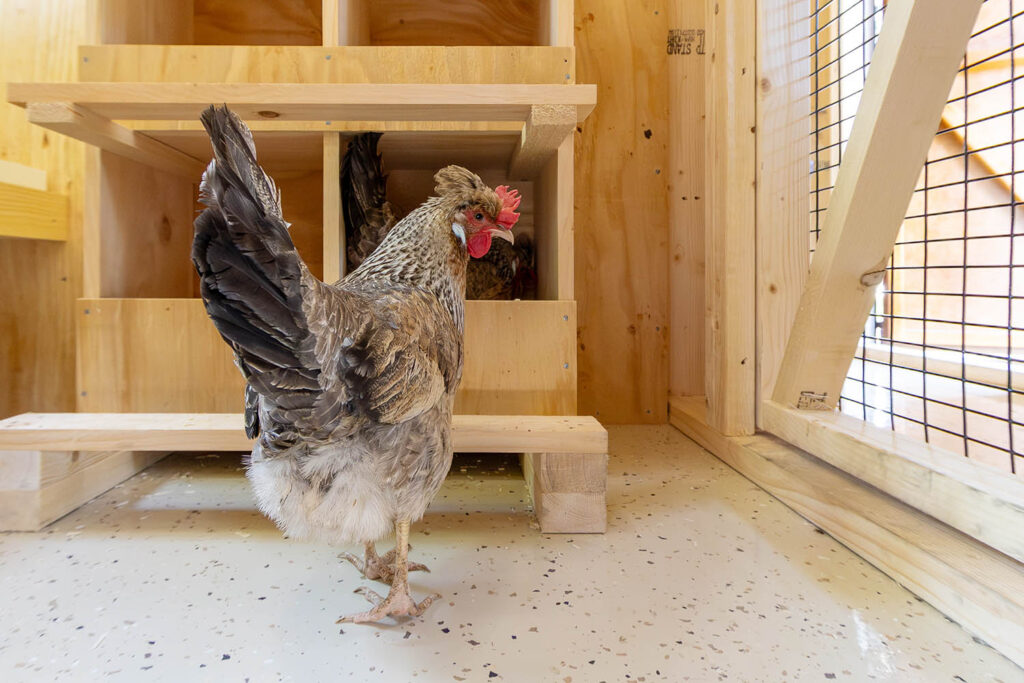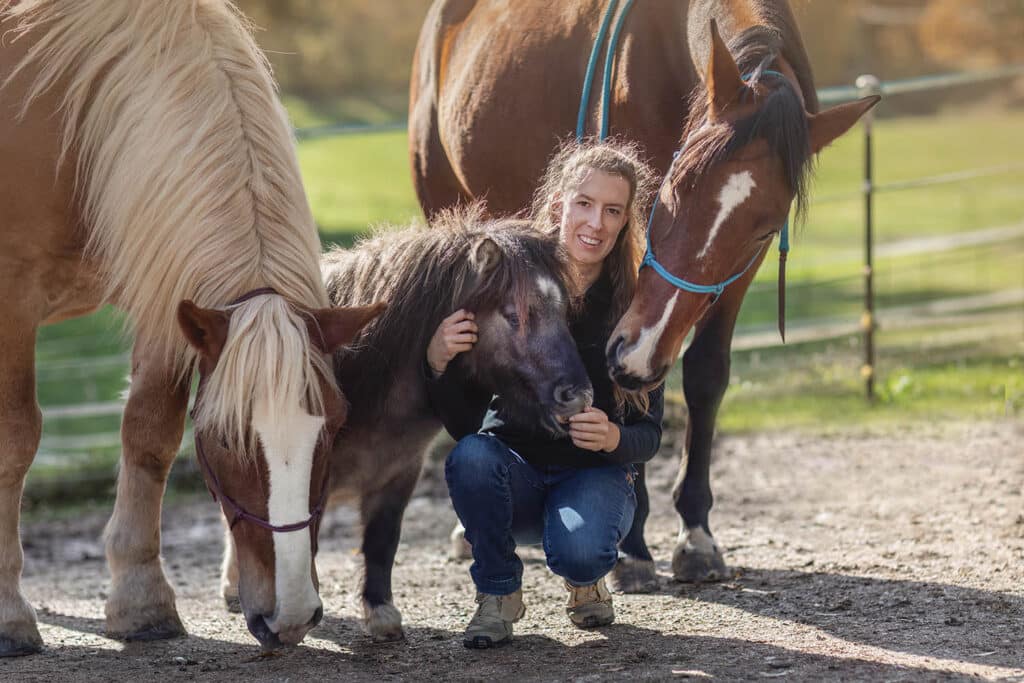In Part 1 of this blog, we met Sarah, a new homesteader in Texas eager to gather her own farm-fresh eggs. For Sarah, the age-old question isn’t “Which came first, the chicken or the egg?” but rather “What size coop should I buy to ensure my flock has the best home possible?”
 Part 2 explores climate considerations, predators and more. PLUS there’s a downloadable “Chicken Coop Sizing for Beginners” checklist at the end!
Part 2 explores climate considerations, predators and more. PLUS there’s a downloadable “Chicken Coop Sizing for Beginners” checklist at the end!
 Sarah learned of a neighbour who lost hens to a raccoon after using a flimsy coop. She’s taking no chances: her coop and run will be like Fort Knox, made of sturdy wood and 1/2-inch hardware cloth wire (instead of thin chicken wire) to keep critters out. Predator-proofing often means a fully enclosed run where chickens can roam safely. Even if you plan to free-range, having a secure run is important for times you can’t supervise. In Sarah’s case, a covered run keeps out hawks and also provides shelter from rain. (As the Meyer Hatchery experts put it, even if you plan to free-range, there will be times you need to fence your flock in for their safety.)
Sarah learned of a neighbour who lost hens to a raccoon after using a flimsy coop. She’s taking no chances: her coop and run will be like Fort Knox, made of sturdy wood and 1/2-inch hardware cloth wire (instead of thin chicken wire) to keep critters out. Predator-proofing often means a fully enclosed run where chickens can roam safely. Even if you plan to free-range, having a secure run is important for times you can’t supervise. In Sarah’s case, a covered run keeps out hawks and also provides shelter from rain. (As the Meyer Hatchery experts put it, even if you plan to free-range, there will be times you need to fence your flock in for their safety.)
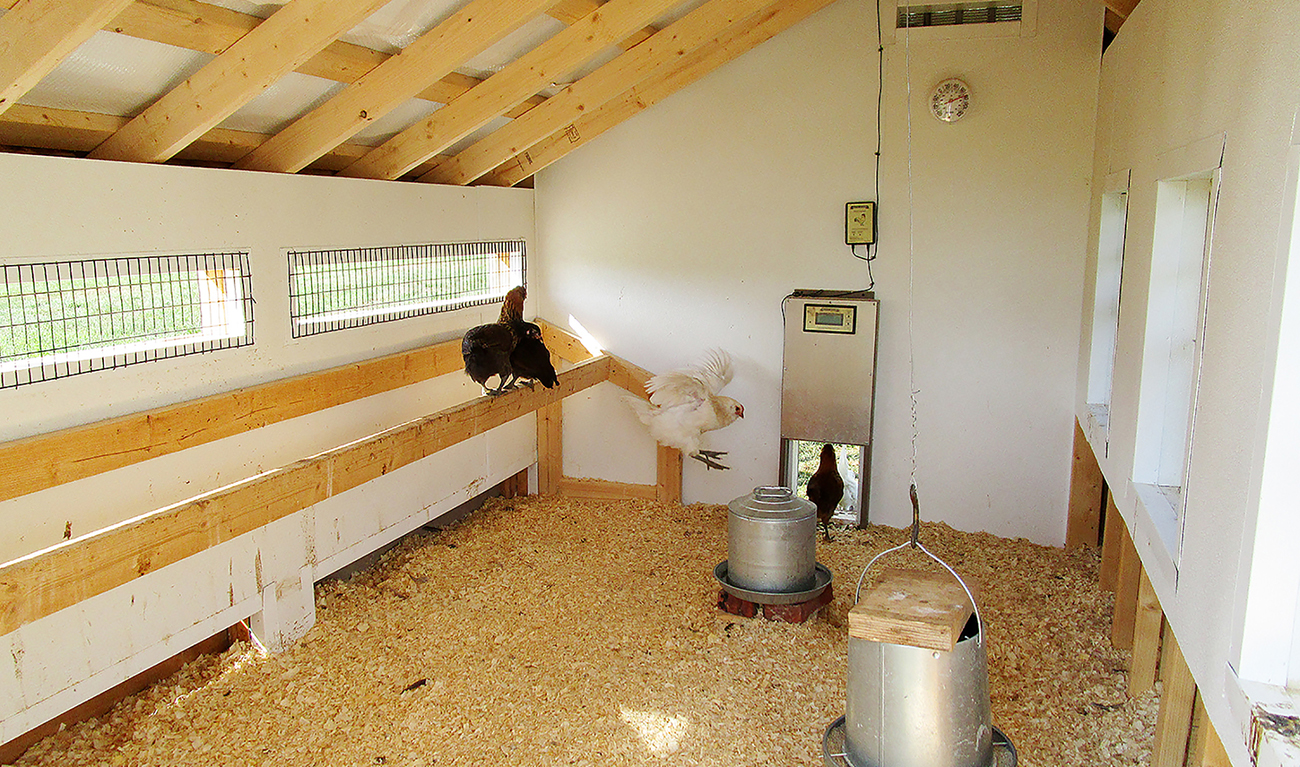
 Designing the right coop can feel daunting, but thankfully there are resources to make it easier. Sarah found an online coop size calculator that lets you plug in the number of chickens and spits out recommended coop and run dimensions. Tools like these (for example, the Omni Calculator – Chicken Coop Size or hatchery websites with charts) help double-check your plans. You can also find printable coop planning charts showing how many square feet are needed for various flock sizes. These guides sometimes include reminders for nest box counts and roost lengths too. While Sarah didn’t rely solely on a calculator, it was a nice way to validate that her 6 chickens truly needed ~60 sq. ft. of run space and that her chosen coop kit was on target.
If you’re not a DIY builder, consider prefab coop options carefully. Look for reviews from other chicken keepers and see if the coop’s real capacity matches your needs. Some U.S. companies offer walk-in coops or shed-style coops that are sold as kits or prebuilt units – these can be great if you’re not handy with carpentry but want something sturdy. Just remember to size up if possible. One handy approach is to buy a garden shed and convert it into a coop, which often provides ample space for a modest flock plus storage for feed and supplies.
Lastly, don’t underestimate the value of community wisdom. Backyard chicken forums, local farm Facebook groups, and TikTok homesteaders are full of seasoned folks happy to share advice. Sarah watched a popular homestead TikToker give a coop tour, where they pointed out how they wished they’d built a bigger run initially. Seeing real examples helped her avoid those pitfalls. You might even find coop tours on YouTube or blog posts with photos and dimensions – great inspiration for planning your own. Pinterest is an excellent resource!
Designing the right coop can feel daunting, but thankfully there are resources to make it easier. Sarah found an online coop size calculator that lets you plug in the number of chickens and spits out recommended coop and run dimensions. Tools like these (for example, the Omni Calculator – Chicken Coop Size or hatchery websites with charts) help double-check your plans. You can also find printable coop planning charts showing how many square feet are needed for various flock sizes. These guides sometimes include reminders for nest box counts and roost lengths too. While Sarah didn’t rely solely on a calculator, it was a nice way to validate that her 6 chickens truly needed ~60 sq. ft. of run space and that her chosen coop kit was on target.
If you’re not a DIY builder, consider prefab coop options carefully. Look for reviews from other chicken keepers and see if the coop’s real capacity matches your needs. Some U.S. companies offer walk-in coops or shed-style coops that are sold as kits or prebuilt units – these can be great if you’re not handy with carpentry but want something sturdy. Just remember to size up if possible. One handy approach is to buy a garden shed and convert it into a coop, which often provides ample space for a modest flock plus storage for feed and supplies.
Lastly, don’t underestimate the value of community wisdom. Backyard chicken forums, local farm Facebook groups, and TikTok homesteaders are full of seasoned folks happy to share advice. Sarah watched a popular homestead TikToker give a coop tour, where they pointed out how they wished they’d built a bigger run initially. Seeing real examples helped her avoid those pitfalls. You might even find coop tours on YouTube or blog posts with photos and dimensions – great inspiration for planning your own. Pinterest is an excellent resource!
 After weeks of planning and building, Sarah finally settles her chickens into their new home. The coop is roomy, the attached run lets them scratch and sunbathe safely, and there’s space to add a few more hens down the road. The chickens quickly begin exploring every corner, flapping up to the roosts, and happily dustbathing in a patch of dry soil Sarah prepared in the run.
By following guidelines and thinking ahead, Sarah avoided the common new-keeper mistake of going too small. She provided at least 4 sq. ft. per hen indoors and ~10 sq. ft. per hen outdoors, as experts recommend. She also kept “chicken math” in mind, future-proofing her coop for the inevitable additions. Now, when she collects her basket of eggs each day, she knows her hens have the space they need to stay healthy, productive, and content.
For new backyard chicken keepers and homesteaders in the U.S., Sarah’s story offers a clear lesson: plan big from the start. Give your chickens a comfortable coop with room to grow, and you’ll reap the rewards of a happy flock. In a time when many are raising chickens to combat high egg prices or to live more sustainably, thoughtful coop sizing is an investment in success. With proper space, climate considerations, and a little forward thinking, your chickens will thrive – and you’ll enjoy every moment of your own backyard chicken journey.
Revisit Part 1 of Sarah’s Smart Coop Sizing journey to see her project from the beginning.
CLICK HERE to download your FREE copy of “Chicken Coop Sizing Checklist for Beginners”!
After weeks of planning and building, Sarah finally settles her chickens into their new home. The coop is roomy, the attached run lets them scratch and sunbathe safely, and there’s space to add a few more hens down the road. The chickens quickly begin exploring every corner, flapping up to the roosts, and happily dustbathing in a patch of dry soil Sarah prepared in the run.
By following guidelines and thinking ahead, Sarah avoided the common new-keeper mistake of going too small. She provided at least 4 sq. ft. per hen indoors and ~10 sq. ft. per hen outdoors, as experts recommend. She also kept “chicken math” in mind, future-proofing her coop for the inevitable additions. Now, when she collects her basket of eggs each day, she knows her hens have the space they need to stay healthy, productive, and content.
For new backyard chicken keepers and homesteaders in the U.S., Sarah’s story offers a clear lesson: plan big from the start. Give your chickens a comfortable coop with room to grow, and you’ll reap the rewards of a happy flock. In a time when many are raising chickens to combat high egg prices or to live more sustainably, thoughtful coop sizing is an investment in success. With proper space, climate considerations, and a little forward thinking, your chickens will thrive – and you’ll enjoy every moment of your own backyard chicken journey.
Revisit Part 1 of Sarah’s Smart Coop Sizing journey to see her project from the beginning.
CLICK HERE to download your FREE copy of “Chicken Coop Sizing Checklist for Beginners”!
 Part 2 explores climate considerations, predators and more. PLUS there’s a downloadable “Chicken Coop Sizing for Beginners” checklist at the end!
Part 2 explores climate considerations, predators and more. PLUS there’s a downloadable “Chicken Coop Sizing for Beginners” checklist at the end!
Climate and Regional Considerations
The United States is a big country, and where you live influences coop needs. Sarah lives in hot, humid Texas – summers reach 100°F. Her coop will need excellent ventilation and shade to keep chickens cool. She installs additional vents and a roof over the run for shade. In contrast, a reader in Minnesota or Maine might prioritize insulation and indoor space, since chickens could be stuck inside during blizzards. In cold regions, a slightly larger coop prevents overcrowding in winter and allows chickens to huddle without smothering each other. Remember that even in winter, ventilation is crucial to remove moisture and ammonia – no coop should be airtight, or it risks frostbite and respiratory issues. Outdoor Space vs. Coop Space: Sarah realizes that because her climate is mild most of the year, her hens will spend a lot of time outdoors. In nice weather, chickens prefer to be out in the run scratching around. If your region allows nearly year-round outdoor time, you might manage with the lower end of indoor space (3 sq. ft/hen) as long as the run is spacious and inviting. On the other hand, if your chickens will be confined more often (due to weather or local predators), err on the side of a bigger coop so they don’t get stressed when kept inside. Predator Pressure: Another U.S.-specific factor is local predators. From rural farms to suburban backyards, chickens attract all sorts of predators – hawks, raccoons, foxes, coyotes, neighbourhood dogs, you name it. Sarah learned of a neighbour who lost hens to a raccoon after using a flimsy coop. She’s taking no chances: her coop and run will be like Fort Knox, made of sturdy wood and 1/2-inch hardware cloth wire (instead of thin chicken wire) to keep critters out. Predator-proofing often means a fully enclosed run where chickens can roam safely. Even if you plan to free-range, having a secure run is important for times you can’t supervise. In Sarah’s case, a covered run keeps out hawks and also provides shelter from rain. (As the Meyer Hatchery experts put it, even if you plan to free-range, there will be times you need to fence your flock in for their safety.)
Sarah learned of a neighbour who lost hens to a raccoon after using a flimsy coop. She’s taking no chances: her coop and run will be like Fort Knox, made of sturdy wood and 1/2-inch hardware cloth wire (instead of thin chicken wire) to keep critters out. Predator-proofing often means a fully enclosed run where chickens can roam safely. Even if you plan to free-range, having a secure run is important for times you can’t supervise. In Sarah’s case, a covered run keeps out hawks and also provides shelter from rain. (As the Meyer Hatchery experts put it, even if you plan to free-range, there will be times you need to fence your flock in for their safety.)
Avoiding Common Mistakes (What Sarah Learned)
Every new chicken keeper makes a few mistakes at first. Sarah is hoping to dodge the big ones by learning from others. Here are some common coop size mistakes and how to avoid them:- Buying a “Too-Small” Coop: Many store-bought coops are much smaller than they appear. Manufacturers often overstate how many chickens they can house. For example, Sarah saw a coop labelled for six chickens that had under 20 sq. ft. of space. Using the 4 sq. ft. rule, that would really only suit 4 chickens at best. Cramming in more leads to crowding. One farm rescue coordinator noted that beginners often buy a simple coop from a farm store, only to find it’s too small as the chickens grow. Solution: Always check the dimensions and do the math yourself. It’s better to have extra room than not enough.
- Ignoring Chicken Math: As discussed, not planning for flock growth is a biggie. If you build exactly for the chickens you have, you might be rebuilding a year later when you fall in love with new breeds or hatch some chicks. Solution: Build bigger than you need at first. An empty corner in the coop is far better than overcrowded birds (and it might get filled sooner than you think!).
- Not Providing a Run/Outdoor Space: A coop alone isn’t enough unless you plan to free-range all day and have no daytime predators. Even a small yard can host a nice, enclosed run. Chickens who are cooped up indoors 24/7 in a tiny space will be stressed. Solution: Pair your coop with a secure run or fenced area so the flock can get fresh air and exercise. The run should offer about 10 sq. ft. per chicken (or more) and be predator-proof (cover the top if hawks are around and bury fencing 12” to deter diggers).
- Skimping on Height and Perches: Chickens feel safest when they can roost up high at night. Coops advertised as “little cottages” may have floor space but not enough height for proper roosts. Likewise, if the coop is too short, it’s hard for you to clean and collect eggs. Solution: Aim for a coop you can stand in or at least kneel in comfortably. Include roosting bars a foot or two off the floor (with 8–12 inches of perch space per bird). This uses vertical space wisely and lets chickens sleep without crowding.

- Poor Ventilation: Even though it’s not directly about size, ventilation goes hand-in-hand with coop design. A larger coop with no windows is not better than a smaller well-ventilated one. Solution: Ensure your coop has vents or mesh areas high up to allow fresh air flow, especially in warm climates. Ventilation helps remove moisture and ammonia fumes. Just avoid drafts blowing directly on roosts in winter.
- Forgetting Future Maintenance: Think about access. Sarah added a full-sized door on her coop and a waist-high clean-out tray. These features don’t change how many chickens fit, but they make a bigger coop much easier to manage. A common mistake is building a coop that’s the right size but hard to get into for cleaning or catching a chicken. Solution: Include human-sized access or large doors. You’ll thank yourself later.
Tools and Resources to Help Plan
 Designing the right coop can feel daunting, but thankfully there are resources to make it easier. Sarah found an online coop size calculator that lets you plug in the number of chickens and spits out recommended coop and run dimensions. Tools like these (for example, the Omni Calculator – Chicken Coop Size or hatchery websites with charts) help double-check your plans. You can also find printable coop planning charts showing how many square feet are needed for various flock sizes. These guides sometimes include reminders for nest box counts and roost lengths too. While Sarah didn’t rely solely on a calculator, it was a nice way to validate that her 6 chickens truly needed ~60 sq. ft. of run space and that her chosen coop kit was on target.
If you’re not a DIY builder, consider prefab coop options carefully. Look for reviews from other chicken keepers and see if the coop’s real capacity matches your needs. Some U.S. companies offer walk-in coops or shed-style coops that are sold as kits or prebuilt units – these can be great if you’re not handy with carpentry but want something sturdy. Just remember to size up if possible. One handy approach is to buy a garden shed and convert it into a coop, which often provides ample space for a modest flock plus storage for feed and supplies.
Lastly, don’t underestimate the value of community wisdom. Backyard chicken forums, local farm Facebook groups, and TikTok homesteaders are full of seasoned folks happy to share advice. Sarah watched a popular homestead TikToker give a coop tour, where they pointed out how they wished they’d built a bigger run initially. Seeing real examples helped her avoid those pitfalls. You might even find coop tours on YouTube or blog posts with photos and dimensions – great inspiration for planning your own. Pinterest is an excellent resource!
Designing the right coop can feel daunting, but thankfully there are resources to make it easier. Sarah found an online coop size calculator that lets you plug in the number of chickens and spits out recommended coop and run dimensions. Tools like these (for example, the Omni Calculator – Chicken Coop Size or hatchery websites with charts) help double-check your plans. You can also find printable coop planning charts showing how many square feet are needed for various flock sizes. These guides sometimes include reminders for nest box counts and roost lengths too. While Sarah didn’t rely solely on a calculator, it was a nice way to validate that her 6 chickens truly needed ~60 sq. ft. of run space and that her chosen coop kit was on target.
If you’re not a DIY builder, consider prefab coop options carefully. Look for reviews from other chicken keepers and see if the coop’s real capacity matches your needs. Some U.S. companies offer walk-in coops or shed-style coops that are sold as kits or prebuilt units – these can be great if you’re not handy with carpentry but want something sturdy. Just remember to size up if possible. One handy approach is to buy a garden shed and convert it into a coop, which often provides ample space for a modest flock plus storage for feed and supplies.
Lastly, don’t underestimate the value of community wisdom. Backyard chicken forums, local farm Facebook groups, and TikTok homesteaders are full of seasoned folks happy to share advice. Sarah watched a popular homestead TikToker give a coop tour, where they pointed out how they wished they’d built a bigger run initially. Seeing real examples helped her avoid those pitfalls. You might even find coop tours on YouTube or blog posts with photos and dimensions – great inspiration for planning your own. Pinterest is an excellent resource!
Conclusion: Sarah’s Flock is Flourishing
 After weeks of planning and building, Sarah finally settles her chickens into their new home. The coop is roomy, the attached run lets them scratch and sunbathe safely, and there’s space to add a few more hens down the road. The chickens quickly begin exploring every corner, flapping up to the roosts, and happily dustbathing in a patch of dry soil Sarah prepared in the run.
By following guidelines and thinking ahead, Sarah avoided the common new-keeper mistake of going too small. She provided at least 4 sq. ft. per hen indoors and ~10 sq. ft. per hen outdoors, as experts recommend. She also kept “chicken math” in mind, future-proofing her coop for the inevitable additions. Now, when she collects her basket of eggs each day, she knows her hens have the space they need to stay healthy, productive, and content.
For new backyard chicken keepers and homesteaders in the U.S., Sarah’s story offers a clear lesson: plan big from the start. Give your chickens a comfortable coop with room to grow, and you’ll reap the rewards of a happy flock. In a time when many are raising chickens to combat high egg prices or to live more sustainably, thoughtful coop sizing is an investment in success. With proper space, climate considerations, and a little forward thinking, your chickens will thrive – and you’ll enjoy every moment of your own backyard chicken journey.
Revisit Part 1 of Sarah’s Smart Coop Sizing journey to see her project from the beginning.
CLICK HERE to download your FREE copy of “Chicken Coop Sizing Checklist for Beginners”!
After weeks of planning and building, Sarah finally settles her chickens into their new home. The coop is roomy, the attached run lets them scratch and sunbathe safely, and there’s space to add a few more hens down the road. The chickens quickly begin exploring every corner, flapping up to the roosts, and happily dustbathing in a patch of dry soil Sarah prepared in the run.
By following guidelines and thinking ahead, Sarah avoided the common new-keeper mistake of going too small. She provided at least 4 sq. ft. per hen indoors and ~10 sq. ft. per hen outdoors, as experts recommend. She also kept “chicken math” in mind, future-proofing her coop for the inevitable additions. Now, when she collects her basket of eggs each day, she knows her hens have the space they need to stay healthy, productive, and content.
For new backyard chicken keepers and homesteaders in the U.S., Sarah’s story offers a clear lesson: plan big from the start. Give your chickens a comfortable coop with room to grow, and you’ll reap the rewards of a happy flock. In a time when many are raising chickens to combat high egg prices or to live more sustainably, thoughtful coop sizing is an investment in success. With proper space, climate considerations, and a little forward thinking, your chickens will thrive – and you’ll enjoy every moment of your own backyard chicken journey.
Revisit Part 1 of Sarah’s Smart Coop Sizing journey to see her project from the beginning.
CLICK HERE to download your FREE copy of “Chicken Coop Sizing Checklist for Beginners”! 

